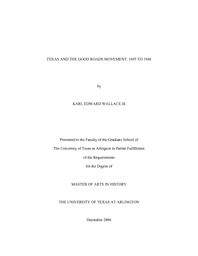| dc.description.abstract | The Good Roads Movement in America grew directly out of concerns over the debilitating effects of rural isolation. However, as each state faced its own unique challenges to the building and maintenance of roads, the early movement reflected broad regional differences. In Texas, the breadth of its borders, the scattered and uneven distribution of its population, and numerous historically rooted prejudices towards the proper role of government defined its differences. Even after the need for good roads had become undeniable, and roads advocacy was galvanized into a national movement, the social and political divisions that existed within Texas would prevent the rapid acceptance of the movement or its goals. The Texas constitution, influenced as it was on post-reconstruction attitudes, made legislative progress next to impossible. Texas would, in fact, be the last state to create any form of highway authority. Only after federal legislation brought the promise of massive federal funding was Texas able to overcome these divisions and create a functioning highway department.After the Texas Highway Department's formation, many of the same divisions that hampered its creation would contribute to hinder its effectiveness. As the legislation that created the department was written as a compromise, it left many issues unresolved. Issues such as funding, the equitable allocation of contracts, and clear divisions of authority among different levels of government, would remain unsettled for years. In addition, as there had never existed in the state a bureaucracy or agency responsible for such large sums of money, unscrupulous politicians began using it as a tool for political patronage and personal profit. As a result, the lobbying efforts of road advocates began reflecting these concerns and road issues became, for the first time, central issues in the mind of the voter. They would in fact determine the rise and fall of numerous administrations and give rise to the most powerful lobby in the state. Although the issue of political abuse was resolved largely in reaction to the suspension of federal aid, the remaining issues would not only continue for years, but would also become the motive force behind road advocacy in the state. Ironically though, the pressures brought by the Great depression and World War Two would ultimately force Texas to address these problems. The shortages of funding, material, and labor brought by the depression and the war left the state with few options other than reform. Once again however, the majority of these reform measures depended on federal intervention for success. | en_US |


